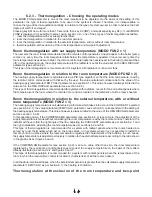
19
adjustment (MODO FUNZ = 4)
The room temperature and the external temperature do not interact on the operating mode of the thermoregulation
in question.
The adjustment of the supply temperature to the radiators is carried out at two temperature levels, set respectively
at TMP MIN RIS (minimum supply temperature, see section 6.2.7) and REG RISCALD (maximum supply
temperature, see section 6.2.8).
The meaning usually attributed to the parameters TMP AMB T0, TMP AMB T1 and TMP AMB T2 (room temperature
levels which can be selected for the automatic operating mode of the room thermostat, see section 5.8), changes
as indicated below:
TMP AMB T0 = heating request absent
TMP AMB T1 = heating request present with supply adjustment at value of TMP MIN RIS parameter
TMP AMB T2 = heating request present with supply adjustment at value of REG RISCALD parameter
By means of the programming of the heating timer (see section 5.8), the user establishes when, over a period of
24 hours, to set the boiler going in heating mode (levels T1 or T2) or not (level T0) and what the setting of the
supply temperature must be (TMP MIN RIS or REG RISCALD) for the water of the heating system.
When this thermoregulation operating mode is selected:
- the PRE RISCALD function (see chapter 6.2.6) is automatically disabled;
- the programming of the TMP AMB T0, TMP AMB T1 and TMP AMB T2 parameters as per section 5.9, is
automatically disabled;
- during the manual adjustment of the room temperature, as per section 5.2, it permits the adjustment of the
desired room temperature, at three levels corresponding to 0 = TMB AMB T0, 1 = TMP AMB T1 and 2 = TMP AMB
T2.
6.2.4 - Hour type displayed
Pressing the KM key down for more than 10 seconds and then key K2 (IMP) followed by key K4 (>>) until TIPO
ORA is displayed, it is possible to select, using keys K+ e K-, the 12 hours or 24 hours timing display. Setting the
parameter at 1, one obtains the 24 hour display, whilst setting it at 2 the 12 hour display is shown.
6.2.5 - Domestic hot water programme type
Pressing the KM key down for more than 10 seconds and then key K2 (IMP) followed by key K4 (>>) until PROGR
SAN is displayed, it is possible to select, using keys K+ e K-, the operating of the domestic hot water function, in
the following manner:
1 = domestic hot water service always active;
2 = possibility of carrying out the time programming of the domestic hot water service independently from the
heating service (the function, when active, is shown on the display using the clock symbol). For the programming
of the domestic hot water service, refer to section 5.8;
3 = the domestic hot water service follows the time programming made for the heating service exactly.
Due to how the boiler is conceived, it is advisable to keep the parameter at 1 or 3.
6.2.6 - Automatic pre-heating
Pressing the KM key down for more than 10 seconds and then key K2 (IMP) followed by key K4 (>>) until PRE
RISCALD is displayed, it is possible to select, using keys K+ e K-, the type of pre-heating one intends to carry out.
The parameter can adopt the following values:
1 = pre-heating enabled in adaptive mode;
2 = pre-heating enabled with a ramp of 3°C/hour;
3 = pre-heating disabled.
If this parameter is set at 3, during the time programming of the heating function, the user must bear in mind to
switch on the heating in advance with respect to the effective need, due to the thermal inertia of the plant (high in
the case of radiant panels, low in the case of radiators, uninfluential in the case of convector fans).
So as to avoid having to take these times into consideration, being among other things difficult to calculate and
variable in relation to the season and type of plant, it is advisable to keep the parameter at the value of 1 or 2, where
the remote time control carries out an automatic detection of the system’s features (with a frequency of 10
minutes), thus calculating the thermal inertia, or the time necessary for achieving a specific room temperature. In





































